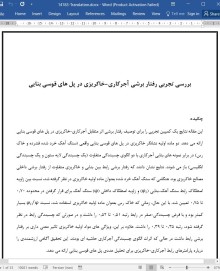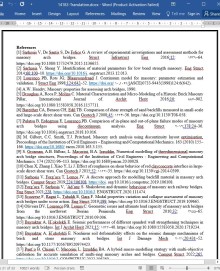
دانلود مقاله بررسی تجربی رفتار برشی آجرکاری-خاکریزی در پل های قوسی بنایی
Abstract
This paper presents the results from an experimental campaign to characterise the shear behaviour of the brickwork-backfill interaction in masonry arch bridges. Two representative backfill materials found in real masonry arch bridges (compacted crushed limestone and clay) were sheared against brickwork masonry specimens with two different bond patterns (a soldier course bond and an English bond). The results demonstrated that the interface shear behaviour between masonry and backfill was different from the internal shear behaviour of backfill materials. When compacted crushed limestone was adopted as the backfill material, the ratio between the masonry-limestone interface friction angle (ϕi) and the internal friction angle (ϕ) of limestone was determined to lie within the range from 0.70 to 0.75. However, when clay was used as backfill material, the ϕi/ϕ ratio was much lower, and of the order of 0.51 to 0.52 under the assumption of zero-cohesion at the interface, or 0.35 to 0.39 if interface cohesion was considered. Moreover, the properties of the backfill material had a significant influence on the interface shear behaviour, whereas the effects of brickwork bonding pattern were marginal. This study provides valuable insight into the identification of brickwork-backfill interface parameters for the numerical analysis of masonry arch bridges.
1. Introduction
Masonry arch bridges form a vital part of the transportation infrastructure systems of many countries. For example, it is estimated that there are approximately 40,000 masonry arch bridges in the UK [1]. To assess load-bearing capacity and to predict the in-service behaviour of masonry arch bridges, reliable numerical or analytical methods are needed. A number of input parameters are generally required for these methods to characterize the behaviour of bridges, including the material properties of the masonry units, mortar joints and backfill, as well as the interface parameters between masonry and backfill. The selection of these parameters plays a determining role in whether the numerical or analytical methods employed can accurately model structural performance, and varying these parameters can significantly impact the calculation results [2,3]. The masonry material properties can be determined by standard small-scale laboratory experiments [4,5]. Also, the properties of the backfill materials, including internal friction angle ϕ and cohesion c, can be characterised via direct shear box tests [6]. However, although masonry and backfill interface parameters (i.e., interface friction angle ϕi (or friction coefficient μi ), interface cohesion ci and stiffness) have been recognised as having a strong influence on the load-carrying capacity of masonry arch bridges [7], there is no commonly used experimental procedure for obtaining them.
Table 1 lists soil properties and interface parameters for masonry arch bridges adopted by researchers in recent studies. A noticeable discrepancy can be observed in the selection of these parameters across studies. For instance, most researchers adopted a ratio of the friction angle of the interface between the masonry-backfill and of the backfill itself (ϕi/ϕ) at approximately 0.70, with a minimum of 0.46 and a maximum of 0.82. One of the reasons for these discrepancies may be the different backfill materials investigated. However, even the studies that adopted the same backfill material (e.g., both [8;9] used crushed limestone backfill), they assigned different ratios of ϕi/ϕ in their numerical models. This inconsistency in parameter settings can be primarily attributed to the limited understanding of the interface interaction between masonry and backfill materials. Moreover, to the best of the authors’ knowledge, no study has considered the influence of backfill properties or masonry bond patterns when selecting interface parameters, despite the fact that masonry of different bond patterns has different surface roughness and texture, which may lead to variations in interface frictional parameters, as previously reported [10].
6. Conclusions
The present study presents an experimental procedure to assess the interface shear behaviour between brickwork masonry and backfill materials. Thirty-six experimental tests were performed to investigate the internal shear behaviour of backfill materials and the interface shear behaviour between brickwork and backfill materials in masonry arch bridges. The brickwork specimens were constructed using Type A bricks with cement mortar to achieve good durability and to keep the surface texture of the specimen effectively unchanged for all 12 experiments carried out on each brickwork specimen. The friction angle and cohesion intercept of limestone, puddling clay, and four types of brickworkbackfill interfaces were characterised. Moreover, the effects of masonry bond patterns and backfill properties on the shear behaviour at brickwork-backfill interfaces were assessed. From the analysis of the results, the following conclusions can be drawn:
• For the brickwork and clay combinations, shear failure occurred at the brickwork-clay interfaces. In these cases, the bond pattern of brickwork was found to affect the movement of clay particles. The values of ϕ iand shear strength obtained from the SC interface were smaller than those obtained from the EC interface due to the aligned joint arrangement of the brickwork specimens with a soldier course bond pattern. However, for the limestone, which had much larger particle sizes, shear failure occurred within the limestone and was of a ductile type. Nevertheless, in the cases investigated in the study, the influence of brickwork bond patterns on the shear behaviour at brickwork-backfill interfaces was not significant and may be considered negligible when assessing masonry arch bridges.
• The properties of the backfill materials had a marked impact on brickwork-backfill interface shear behaviour. The critical shear strain, peak shear stress and interface friction angle of brickworklimestone interfaces were significantly larger than those of brickwork-clay interfaces.
• The internal angle of friction of the backfill materials was higher than the interface angle of friction between brickwork and backfill. On the other hand, backfill type was found to significantly affect the shear behaviour at the brickwork-backfill interface. In the case of limestone backfill, ϕi/ϕ ranged from 0.70 to 0.75. In the case of clay backfill, ϕi/ϕ was determined to be 0.51 to 0.52 under the assumption of zero-cohesion at the masonry-clay interface, or 0.35 to 0.39 if interface cohesion was taken into account. These ratios provide experimentally-derived parameters that researchers and practicing engineers can refer to when modelling masonry arch bridges numerically.
چکیده
1. مقدمه
2. برنامه ازمایشی
2.1. واحد، ملات، و نمونه های بنایی
2.2. نمونه های آجرکاری
2.3. آزمایشات برش مستقیم بر روی مصالح خاکریزی
3. آزمایشات مقاومت برشی رابط آجرکاری-خاکریزی
3.1. تعیین سطوح تنش طبیعی
3.2. روش های آزمایش برش رابط
4. نتایج تجربی
4.1. نتایج آزمایش برش مستقیم بر روی خاک رس و سنگ آهک
4.2. نتایج تجربی در رابط های آجرکاری-خاکریزی
5. بحث
5.1. تاثیر الگوهای باند بر رفتار برشی رابط آجرکاری-خاکریزی
5.2. تاثیر ویژگی های خاکریزی بر رفتار برشی بین رابط های آجرکاری-خاکریزی
5.3. مقایسه رفتار برشی داخلی خاکریزی ها و رفتار برشی رابط بین آجرکاری و خاکریزی
6. نتیجه گیری ها
منابع
Abstract
1. Introduction
2. Experimental programme
2.1. Units, mortar, and masonry specimens
2.2. Brickwork specimens
2.3. Direct shear tests on backfill materials
3. Brickwork-backfill interface shear strength tests
3.1. Determination of normal stress levels
3.2. Interface shear test procedures
4. Experimental results
4.1. Direct shear test results on clay and limestone
4.2. Experimental results on brickwork-backfill interfaces
5. Discussion
5.1. Influence of bond patterns on the shear behaviour of brickwork-backfill interface
5.2. Influence of backfill properties on the shear behaviour between brickwork-backfill interfaces
5.3. Comparison of the internal shear behaviour of backfills and interface shear behaviour between brickwork and backfill
6. Conclusions
References
این محصول شامل پاورپوینت ترجمه نیز می باشد که پس از خرید قابل دانلود می باشد. پاورپوینت این مقاله حاوی 32 اسلاید و 6 فصل است. در صورت نیاز به ارائه مقاله در کنفرانس یا سمینار می توان از این فایل پاورپوینت استفاده کرد.
در این محصول، به همراه ترجمه کامل متن، یک فایل ورد ترجمه خلاصه نیز ارائه شده است. متن فارسی این مقاله در 13 صفحه (2800 کلمه) خلاصه شده و در داخل بسته قرار گرفته است.
علاوه بر ترجمه مقاله، یک فایل ورد نیز به این محصول اضافه شده است که در آن متن به صورت یک پاراگراف انگلیسی و یک پاراگراف فارسی درج شده است که باعث می شود به راحتی قادر به تشخیص ترجمه هر بخش از مقاله و مطالعه آن باشید. این فایل برای یادگیری و مطالعه همزمان متن انگلیسی و فارسی بسیار مفید می باشد.
بخش مهم دیگری از این محصول لغت نامه یا اصطلاحات تخصصی می باشد که در آن تعداد 60 عبارت و اصطلاح تخصصی استفاده شده در این مقاله در یک فایل اکسل جمع آوری شده است. در این فایل اصطلاحات انگلیسی (تک کلمه ای یا چند کلمه ای) در یک ستون و ترجمه آنها در ستون دیگر درج شده است که در صورت نیاز می توان به راحتی از این عبارات استفاده کرد.
- ترجمه فارسی مقاله با فرمت ورد (word) با قابلیت ویرایش و pdf بدون آرم سایت ای ترجمه
- پاورپوینت فارسی با فرمت pptx
- خلاصه فارسی با فرمت ورد (word)
- متن پاراگراف به پاراگراف انگلیسی و فارسی با فرمت ورد (word)
- اصطلاحات تخصصی با فرمت اکسل



